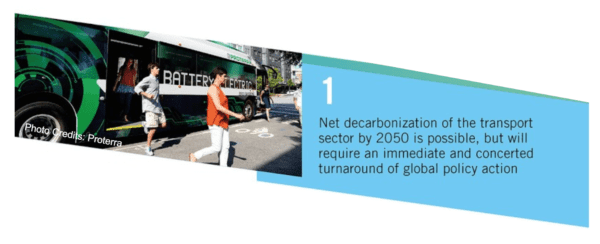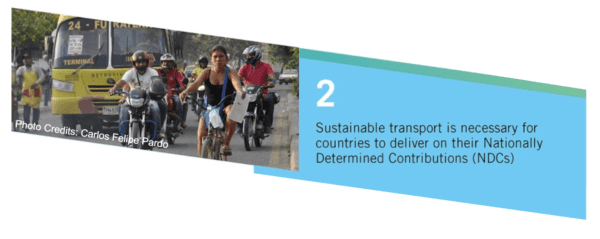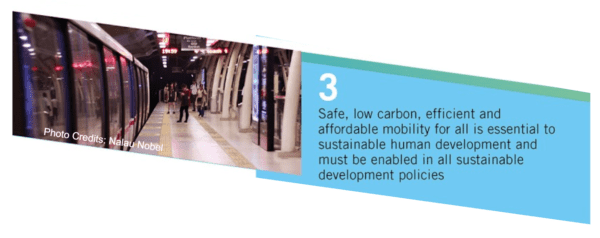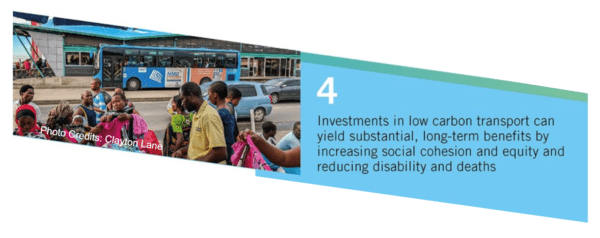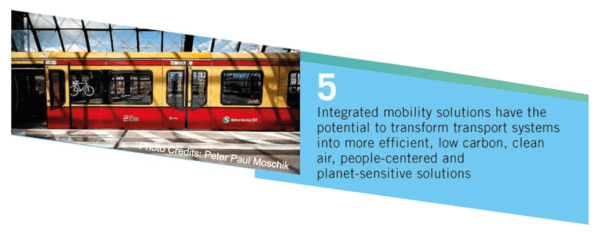Transport contributes roughly one quarter of global energy related GHG emissions and one sixth of all emissions and is the fastest growing emissions sector. Without rapid and ambitious mitigation action, transport emissions could more than double by 2050.
Key Message 1: Net decarbonization of the transport sector by 2050 is possible, but will require an immediate and concerted turnaround of global policy action
- According to the IPCC Special Report, a 1.5˚C pathway for transport is possible with strengthened policy measures, increased mitigation investments, accelerated technological innovation and behavior change.
- Low carbon, cost-effective solutions for roadway, rail, air and maritime passenger and freight transport modes are available and have been tested at scale across regions of the globe.
- Concerted national, regional and urban policy frameworks together with private sector action (through the Transport Decarbonisation Alliance and related initiatives) are required to avoid unnecessary trips, shift to more efficient modes, and improve transport vehicles and energy sources.
Key Message 2: Sustainable transport is necessary for countries to deliver on their Nationally Determined Contributions (NDCs)
- More specific and ambitious targets for reducing carbon emissions from transport are needed in NDCs to achieve full mitigation potential of the sector, which produces roughly 25% of energy related GHG emissions.
- Clear roadmaps for net decarbonization of the transport sector by 2050 need to be developed (e.g. Transport Decarbonisation Alliance “fast track” approach, sustainable urban mobility plans) and synchronized at all tiers of government (i.e. local, provincial, national, regional, global).
- Countries must implement policies required for long-term low carbon transformation of transport systems, including coordinated planning, rational pricing of road space and fuels, and technology deployment.
Key Message 3: Safe, low carbon, efficient and affordable mobility for all is essential to sustainable human development and must be enabled in all sustainable development policies
- Action on low carbon transport supports eight of 17 Sustainable Development Goals and accelerates progress on the New Urban Agenda and other global agreements, with benefits of improved road safety, urban access and air quality.
- National mobility policies can play a strong role in reducing costs to accelerate sustainable transport, and city and private sector initiatives can drive behavior change if enabled and incentivized by all levels of government.
- Improving access to economic, social and cultural opportunities with low-cost, low-emission transport options across urban-rural linkages can deliver social and economic progress especially for marginalized groups.
Key Message 4: Investments in low carbon transport can yield substantial, long-term benefits by increasing social cohesion and equity and reducing disability and deaths
- There is a growing need for sustainable transport investment. Comprehensive, consistent national and sub-national institutional and policy frameworks can drive public spending, stimulate private investment, and generate innovative financing models.
- Adapting transport infrastructure and services to extreme temperatures, precipitation and sea-level rise is necessary to improve resilience of transport systems and increase long-term returns on investment.
- Investment in low carbon transport combined with land use planning can lead to financial savings and quality-of-life benefits that extend beyond the scale, time, and budget of the investments themselves.
Key Message 5: Integrated mobility solutions have the potential to transform transport systems into more efficient, low carbon, clean air, people-centered and planet-sensitive solutions
- New mobility solutions (including bike-, car- and ride-sharing) offer a more efficient usage of (especially autonomous) vehicles and infrastructure, if properly integrated with walking, cycling and public transport.
- Transport electrification must be closely linked to renewable energy (with electric vehicles contributing storage capacity) in conjunction with reducing, shifting and sharing trips; next-generation transport fuels must have low lifecycle carbon footprints.
- Information and communication technologies can facilitate sustainable multimodal journeys for individual travelers, and can increase efficiency of freight and logistics by optimizing capacity and reducing empty vehicle trips.
Key Message 6: The Paris Process on Mobility and Climate and the global transport community stand ready to support development and implementation of country, city and company actions on climate change and transport
- The transport community is supporting governments to develop, implement and maintain their NDCs and long-term low emission development strategies.
- The transport community is providing policy advice and expertise to the UNFCCC process to help catalyse the decarbonisation of the transport sector and to develop capacities of individuals and institutions.
- The transport community is co-operating with other sectors (such as energy, health, education, human settlements and finance) to catalyse effective and enduring climate action.
- Enabling the full transformative potential of the global transport community will require a substantial and sustained increase in funding.

